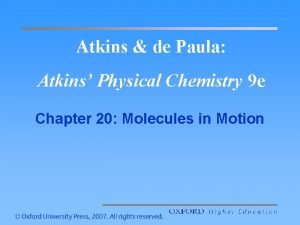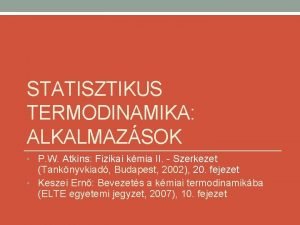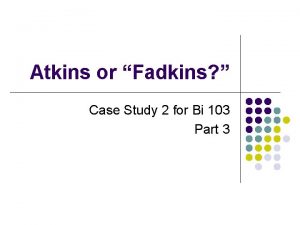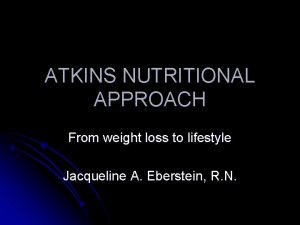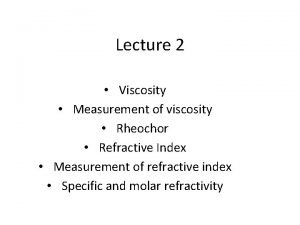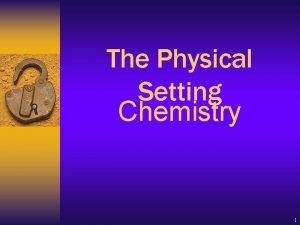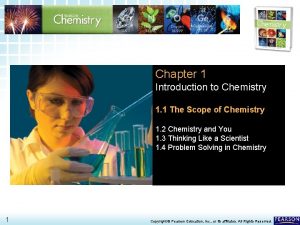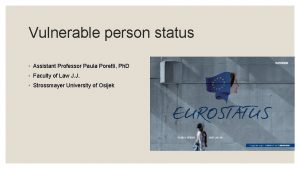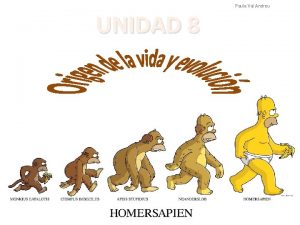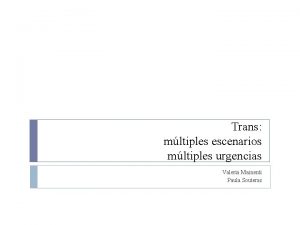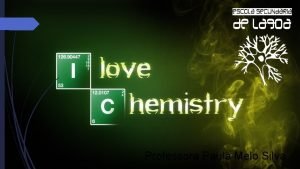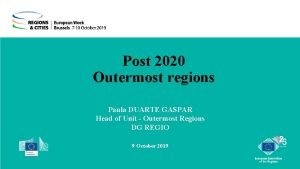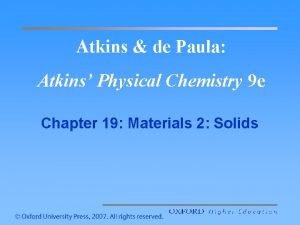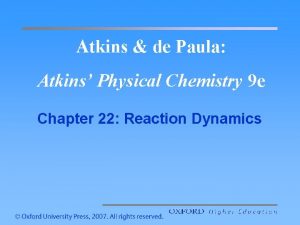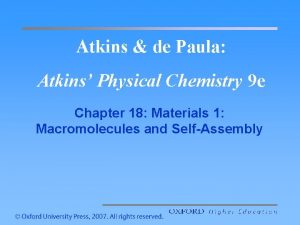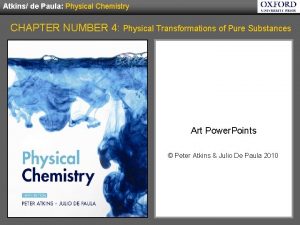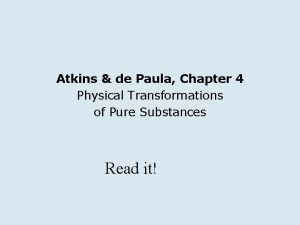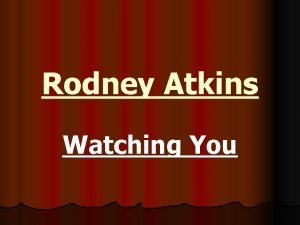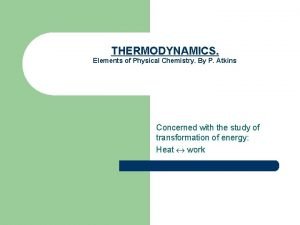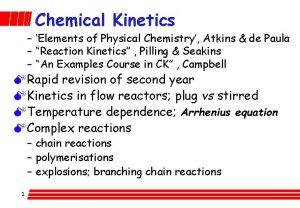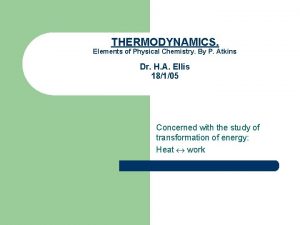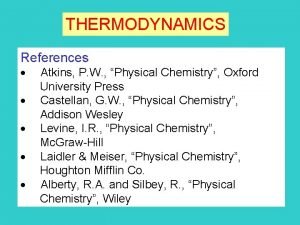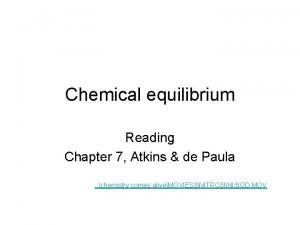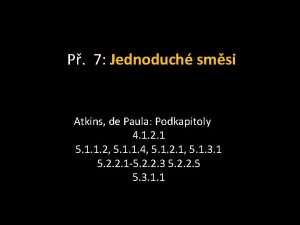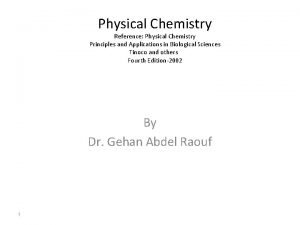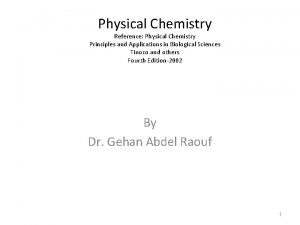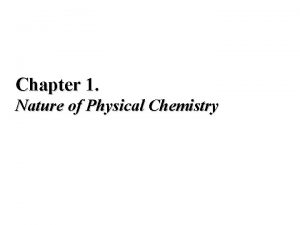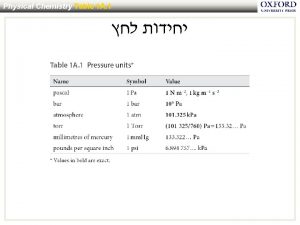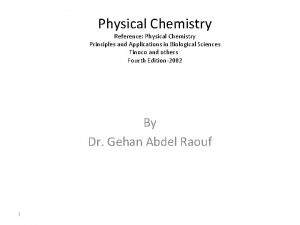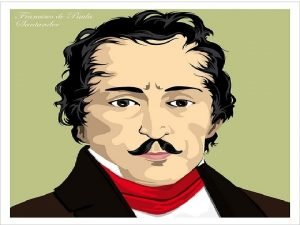Atkins de Paula Atkins Physical Chemistry 9 e
































- Slides: 32

Atkins & de Paula: Atkins’ Physical Chemistry 9 e Chapter 21: The Rates of Chemical Reactions

Chapter 21: The Rates of Chemical Reactions chemical kinetics, the study of reaction rates. mechanism of reaction, the sequence of elementary steps involved in a reaction. CHEMICAL KINETICS 21. 1 Experimental techniques real-time analysis, a procedure in which the composition of a system is analysed while the reaction is in progress. (1)flow method, a procedure in which the composition of a system is analysed as the reactants flow into a mixing chamber. (2)stopped-flow technique, a procedure in which the reagents are mixed very quickly in a small chamber fitted with a syringe instead of an outlet tube.

Chapter 21: The Rates of Chemical Reactions (3) flash photolysis, a procedure in which the reaction is initiated by a brief flash of light. quenching methods, techniques based on stopping the reaction after it has been allowed to proceed for a certain time. (1)chemical quench flow method, a technique in which the reactants are mixed as in the flow method but the reaction is quenched by another reagent. (2)freeze quench method, a technique in which the reaction is quenched by cooling the mixture.

Chapter 21: The Rates of Chemical Reactions 21. 2 The rates of reactions 21. 2(a) The definition of rate of consumption of a reactant R, –d[R]/dt. rate of formation of a product P, d[P]/dt. rate of reaction, v = (1/V)dξ/dt where ξ is the extent of reaction. rate of homogeneous reaction, v = (1/v. J)d[J]/dt. rate of heterogeneous reaction, v = (1/v. J)dσJ/dt. 21. 2(b) Rate laws and rate constants rate law, the rate as a function of concentration, v = f([A], [B], . . . ). rate constant, the constant k in a rate law. hydrogen–bromine reaction: the observed rate law is d[HBr]/dt = kr[H 2][Br 2]3/2/([Br 2] + kr [HBr]). 21. 2(c) Reaction order reaction order, the power to which the concentration of a species is raised in a rate law of the form v = [A]a[B]b. . first-order reaction, a reaction with a rate law of the form v = kr[A]. second-order reaction, a reaction with a rate law of the form v = kr[A]2. overall order, the sum of the orders a + b +. . . , in a rate law of the form v = kr[A]a[B]b. . zero-order rate law, a rate law of the form v = kr.

Chapter 21: The Rates of Chemical Reactions 21. 2(d) The determination of the rate law isolation method, a procedure in which the concentrations of all the reactants except one are in large excess. Pseudo first-order rate law, v = kr [A] with kr = kr[B]0 by maintaining B in large excess. Na. BH 4 Ag. NPs Nanoparticle Catalyst S. W. Han et al. , Chem. Lett. , 2007, 36, 1350.

Chapter 21: The Rates of Chemical Reactions method of initial rates, a procedure in which the rate is measured at the beginning of the reaction for several different initial concentrations of reactants; v 0 = kr [A]0 a log v 0 = log kr + a log [A]0. Example 21. 2

Chapter 21: The Rates of Chemical Reactions 21. 3 Integrated rate laws integrated rate law, the integrated form of a rate law for concentration as a function of time. 21. 3(a) First-order reactions first-order integrated rate law, -d[A]/dt= kr[A] ln([A]/[A]0) = –krt, [A] = [A]0 e–krt. half life, t 1/2 = (ln 2)/kr. time constant, the time required for the concentration of a reactant to fall to 1/e of its initial value, τ = 1/kr. Example 21. 3

Chapter 21: The Rates of Chemical Reactions 21. 3(c) Second-order reactions second-order integrated rate law, -d[A]/dt= kr[A]2 1/[A] – 1/[A]0 = krt [A] = [A]0/(1 + krt[A]0). half life, t 1/2 = 1/kr[A]0. half life for nth-order reaction (n>1), t 1/2 = 2 n-1 -1/(n-1)kr[A]0 n-1.

Chapter 21: The Rates of Chemical Reactions Check this out!

Chapter 21: The Rates of Chemical Reactions 21. 4 Reactions approaching equilibrium 21. 4(a) First-order reactions close to equilibrium

Chapter 21: The Rates of Chemical Reactions 21. 4(b) Relaxation methods relaxation, the return to equilibrium. temperature jump, a procedure in which a sudden temperature rise is imposed and the system returns to equilibrium. pressure-jump techniques, as for temperature jump, but with a sudden change in pressure.

Chapter 21: The Rates of Chemical Reactions 21. 5 The temperature dependence of reaction rates Arrhenius equation, ln k = ln A – Ea/RT. pre-exponential factor (frequency factor), the parameter A in the Arrhenius equation. activation energy, the parameter Ea in the Arrhenius equation; the minimum kinetic energy for reaction during a molecular encounter. Arrhenius parameters, the parameters A and Ea. generalized activation energy, Ea = RT 2(d ln k/d. T). activated complex, the cluster of atoms that corresponds to the region close to the maximum potential energy along the reaction coordinate. transition state, a configuration of atoms in the activated complex which, if attained, leads to products.

Chapter 21: The Rates of Chemical Reactions ACCOUNTING FOR THE RATE LAWS 21. 6 Elementary reactions elementary reaction, a single step in a reaction mechanism. H + Br 2 HBr + Br molecularity, the number of molecules coming together to react in an elementary reaction order, the power to which the concentration of a species is raised in a rate law of the form v = [A]a[B]b. . . ; an empirical quantity, and obtained from the experimental rate law. unimolecular reaction, an elementary reaction involving a single reactant molecule. bimolecular reaction, an elementary reaction involving the encounter of two reactant molecules. CH 3 I(alc) + CH 3 CH 2 O-(alc) CH 3 OCH 2 CH 3(alc) + I-(alc) Mechanism: CH 3 I + CH 3 CH 2 O- CH 3 OCH 2 CH 3 + I-, a single elementary step Rate law: v=kr[CH 3 I][CH 3 CH 2 O-]

Chapter 21: The Rates of Chemical Reactions 21. 7 Consecutive elementary reactions consecutive first-order reactions, a sequence of first-order reactions.

Chapter 21: The Rates of Chemical Reactions steady-state approximation (or quasi-steady-state approximation, QSSA) the rates of change of concentrations of all reaction intermediates are negligibly small: d[I]/dt 0 and their concentrations are low. induction period, the initial stage of a reaction during which reaction intermediates are formed.

Chapter 21: The Rates of Chemical Reactions validation of steady-state approximation (QSSA)

Chapter 21: The Rates of Chemical Reactions An example of steady-state approximation

Chapter 21: The Rates of Chemical Reactions rate-determining step, the step in a mechanism that controls the overall rate of the reaction; commonly but not necessarily the slowest step.

Chapter 21: The Rates of Chemical Reactions pre-equilibrium, a state in which an intermediate is in equilibrium with the reactants and which arises when the rates of formation of the intermediate and its decay back into reactants are much faster than its rate of formation of products.

Chapter 21: The Rates of Chemical Reactions Examples of reaction mechanisms 21. 8 Unimolecular reactions Lindemann–Hinshelwood mechanism, a theory of ‘unimolecular’ reactions.

Chapter 21: The Rates of Chemical Reactions Test of Lindemann–Hinshelwood mechanism activation energies of composite reactions

Chapter 21: The Rates of Chemical Reactions 21. 9 POLYMERIZATION KINETICS stepwise polymerization, a polymerization reaction in which any two monomers present in the reaction mixture can link together at any time and the growth of the polymer is not confined to chains that are already forming. chain polymerization, a polymerization reaction in which an activated monomer attacks another monomer, links to it, then that unit attacks another monomer, and so on. stepwise polymerization chain polymerization

Chapter 21: The Rates of Chemical Reactions 21. 9(a) Stepwise polymerization degree of polymerization, the average number of monomer residues per polymer molecule, n = 1/(1 – p), where p is the average number of monomers per polymer molecule; n = 1 + krt[A]0.

Chapter 21: The Rates of Chemical Reactions 21. 9(b) Chain polymerization rate of chain polymerization

Chapter 21: The Rates of Chemical Reactions kinetic chain length, v, the ratio of the number of monomer units consumed per activated centre produced in the initiation step; v = k[M][I]–½.

Chapter 21: The Rates of Chemical Reactions 21. 10 PHOTOCHEMISTRY primary process, a process in which products are formed directly from the excited state of a reactant. secondary process, a process in which products originate from intermediates formed directly from the excited state of a reactant.

Chapter 21: The Rates of Chemical Reactions 21. 10(a) The primary quantum yield, ϕ, the number of photophysical or photochemical events that lead to primary products divided by the number of photons absorbed by the molecule in the same interval, ϕ = v/Iabs.

Chapter 21: The Rates of Chemical Reactions 21. 10(b) Mechanism of decay of excited singlet states

Chapter 21: The Rates of Chemical Reactions 21. 10(c) Quenching quenching, shortening of the lifetime of an excited state. Stern–Volmer equation, φf, 0/φf = 1 + τ0 k. Q[Q]. Stern–Volmer plot

Chapter 21: The Rates of Chemical Reactions Modified Stern–Volmer equation Example 21. 9 Q: Fe(OH 2)63+

Chapter 21: The Rates of Chemical Reactions Three common mechanism of quenching 21. 10(d) Resonance energy transfer Förster theory, a theory of resonance energy transfer, - efficiency (ηT =1 -φf, 0/φf); ηT 1/R 6 [ηT = R 06/(R 06 + R 6)]. - h donor h acceptor

Chapter 21: The Rates of Chemical Reactions fluorescence resonance energy transfer (FRET), a technique used to measure distances in biological systems. ηT =1 -φf, 0/φf ηT = R 06/(R 06 + R 6) 7. 9 nm Protein rhodopsin
 Dz atkins
Dz atkins Sample atkins diet phase 1
Sample atkins diet phase 1 Gerald gallego victims
Gerald gallego victims Facts about tactile learners
Facts about tactile learners Atkins fizikai kémia
Atkins fizikai kémia Uncc library login
Uncc library login Atkins and murphy reflective model
Atkins and murphy reflective model Types of ergonomics
Types of ergonomics Atkins or fadkins case study answers
Atkins or fadkins case study answers Atkins lifestyle
Atkins lifestyle Functional groups ib chemistry
Functional groups ib chemistry Organic vs inorganic chemistry
Organic vs inorganic chemistry Rheochor
Rheochor Physical setting chemistry
Physical setting chemistry Physical chemistry crash course
Physical chemistry crash course Hittorf rule of migration of ions
Hittorf rule of migration of ions Physical chemistry problems
Physical chemistry problems Scope of physical chemistry
Scope of physical chemistry Changes in matter
Changes in matter The pricing tripod
The pricing tripod Physical fitness grade 9
Physical fitness grade 9 Paula poretti
Paula poretti Dr aaron gilliam
Dr aaron gilliam Puntualismo
Puntualismo Paula figari
Paula figari Trans paula valeria bedoya
Trans paula valeria bedoya Jari kajas
Jari kajas Superman and paula brown’s new snowsuit by sylvia plath
Superman and paula brown’s new snowsuit by sylvia plath Superman and paula brown's new snowsuit analysis
Superman and paula brown's new snowsuit analysis Paula reponen rovaniemi
Paula reponen rovaniemi 6 podstawowych emocji według paula ekmana
6 podstawowych emocji według paula ekmana Paula melo silva
Paula melo silva üep
üep
